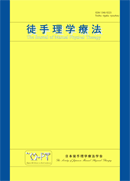Volume 19, Issue 2
Displaying 1-7 of 7 articles from this issue
- |<
- <
- 1
- >
- >|
-
2019 Volume 19 Issue 2 Pages 43-
Published: 2019
Released on J-STAGE: October 23, 2019
Download PDF (668K)
Original Article
-
2019 Volume 19 Issue 2 Pages 45-48
Published: 2019
Released on J-STAGE: October 23, 2019
Download PDF (415K) -
Effect of patellofemoral joint mobilization in the caudal direction on knee extensor muscle strength2019 Volume 19 Issue 2 Pages 49-54
Published: 2019
Released on J-STAGE: October 23, 2019
Download PDF (396K)
Case Study
-
2019 Volume 19 Issue 2 Pages 55-59
Published: 2019
Released on J-STAGE: October 23, 2019
Download PDF (860K)
Review
-
2019 Volume 19 Issue 2 Pages 61-66
Published: 2019
Released on J-STAGE: October 23, 2019
Download PDF (312K)
Introductions
-
2019 Volume 19 Issue 2 Pages 67-71
Published: 2019
Released on J-STAGE: October 23, 2019
Download PDF (586K) -
2019 Volume 19 Issue 2 Pages 73-77
Published: 2019
Released on J-STAGE: October 23, 2019
Download PDF (671K)
- |<
- <
- 1
- >
- >|
